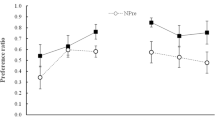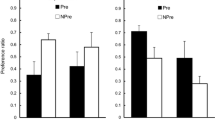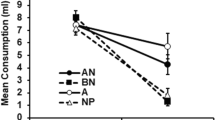Abstract
Taste-aversion learning has been a popular paradigm for examining associative processes because it often produces outcomes that are different from those observed in other classical conditioning paradigms. One such outcome is taste-mediated odor potentiation in which aversion conditioning with a weak odor and a strong taste results in increased or synergistic conditioning to the odor. Because this strengthened odor aversion was not anticipated by formal models of learning, investigation of taste-mediated odor potentiation was a hot topic in the 1980s. The present manuscript reviews the history of potentiation research with particular focus given to the stimuli that produce potentiation, the conditions that produce potentiation, the possible mechanism of this phenomenon, and possible reasons for the decline of research in this area. Although the number of published reports of potentiation has decreased since the 1980s, recent physiological and behavioral assessments have advanced the field considerably, and the opportunities for future research are bountiful. Recent physiological experiments, for example, have identified the basolateral nucleus of the amygdala as the key brain region to produce taste-mediated odor potentiation (e.g., Hatfield andGallagher, 1995). Also, recent behavioral experiments have extended the generality of synergistic conditioning effects. Studies have shown that odor can potentiate responding to taste (Slotnick, Westbrook and Darling, 1997) and that augmented responding can be produced in the A+/AX+blocking design (e.g., Batsell and Batson, 1999). With the current understanding of where synergistic conditioning may occur in the brain and the new tools to explore synergistic conditioning, we propose various directions for future research to determine whether taste-aversion learning and synergistic conditioning require unique explanations.
Similar content being viewed by others
References
Baker, L.M., Best, M.R. and Domjan, M. (eds), 1977: Learning Mechanisms in Food Selection, Baylor University Press, Waco, TX.
Batsell, W.R., Jr. and Batson, J.D., 1999: Augmentation of taste conditioning by a preconditioned odor, Journal of Experimental Psychology: Animal Behavior Processes 25, 374–388.
Batsell, W.R., Jr., Paschall, G.Y., Gleason, D.I. and Batson, J.D., 2001: Taste preconditioning augments odor–aversion learning, Journal of Experimental Psychology: Animal Behavior Processes 27, 30–47.
Batsell, W.R., Jr., Trost, C., Cochran, S., Blankenship, A.G. and Batson, J.D., in press: Effects of postconditioning inflation on odor + taste compound conditioning, Learning & Behavior.
Batson, J.D. and Batsell, W.R., Jr., 2000: Augmentation, not blocking, in an A+/AX+ flavorconditioning procedure, Psychonomic Bulletin & Review 7, 466–471.
BermÚdez–Rattoni, F., Coburn, K.L., Fernandez, J., Chavez, A.F. and Garcia, J., 1987: Potentiation of odor by taste and odor aversions in rats are regulated by cholinergic activity of dorsal hippocampus, Pharmacology, Biochemistry, & Behavior 26, 553–559.
BermÚdez–Rattoni, F., Grijalva, C.V., Kiefer, S.W. and Garcia, J., 1986: Flavor–illness aversions: The role of the amygdala in the acquisition of taste–potentiated odor aversions, Physiology & Behavior 38, 503–508.
BermÚdez–Rattoni, F., Rusiniak, K.W. and Garcia, J., 1983: Flavor–illness aversions: Potentiation of odor by taste is disrupted by application of novocaine into amygdala, Behavioral and Neural Biology 37, 61–75.
Best, M.R., Batson, J.D., Meachum, C.L., Brown, E.R. and Ringer, M., 1985: Characteristics of taste–mediated environmental potentiation in rats, Learning and Motivation 16, 190–209.
Best, M.R., Brown, E.R. and Sowell, M.K., 1984: Taste–mediated potentiation of noningestional stimuli in rats, Learning and Motivation 15, 244–258.
Bouton, M.E., 1993: Context, time, and memory retrieval in the interference paradigms of Pavlovian learning, Psychological Bulletin 114, 80–99.
Bouton, M.E., Dunlap, C.M. and Swartzentruber, D.: 1987, Potentiation of taste by another taste during compound aversion Conditioning, Animal Learning & Behavior 15, 433–438.
Bouton, M.E., Jones, D.L., McPhillips, S.A. and Swartzentruber, D.: 1986, Potentiation and overshadowing in odor–aversion learning: Role of method of odor presentation, the distal–proximal cue distinction, and the conditionability of odor, Learning and Motivation 17, 115–138.
Bouton, M.E. and Whiting, M.R., 1982: Simultaneous odor–taste and taste–taste compounds in poison–avoidance learning, Learning and Motivation 13, 472–494.
Bryant, P.A., Boakes, R.A. and McGregor, I.S., 1993: Taste–potentiated odor aversion learning based on amphetamine, Physiology & Behavior 54, 393–398.
Bures, J., BermÚdez–Rattoni, F. and Yamamoto, T., 1998: Conditioned Taste Aversion: Memory of a Special Kind, Oxford University Press, Oxford.
Capaldi, E.D. and Hunter, M.J., 1994: Taste and odor in conditioned flavor preference learning, Animal Learning & Behavior 22, 355–365.
Coburn, K.L., Garcia, J., Kiefer, S.W. and Rusiniak, K.W., 1984: Taste potentiation of poisoned odor by temporal contiguity, Behavioral Neuroscience 98, 813–819.
Davis, S.F., Best, M.R. and Grover, C.A., 1988: Toxicosis–mediated potentiation in a taste/taste compound: Evidence for within–compound associations, Learning and Motivation 19, 183–205.
Davis, S.F., Best, M.R., Grover, C.A., Bailey, S.A., Freeman, B.L. and Mayleben, M.A., 1990: The effects of taste extinction on ingestinal potentiation in weanling rats, Animal Learning & Behavior 18, 444–452.
Domjan, M., 1985: Cu–consequence specificity and long–delay learning revisited, in N.S. Braveman and P. Bronstein (eds), Experimental Assessments and Clinical Applications of Conditioned Food Aversions (Annals of the New York Academy of Sciences, Vol. 443), New York Academy of Sciences, New York, pp. 54–66.
Droungas, A. and LoLordo, V.M., 1991: Taste–mediated potentiation of odor aversion induced by lithium chloride: Effects of preconditioning exposure to the conditioned stimulus and postconditioning extinction of the taste aversion, Learning and Motivation 22, 291–310.
Durlach, P.J. and Rescorla, R.A., 1980: Potentiation rather than overshadowing in flavor–aversion learning: An analysis in terms of within–compound associations, Journal of Experimental Psychology: Animal Behavior Processes 6, 175–187.
Ellins, S.R. and von Kluge, S., 1987: Preexposure and extinction effects of lithium chloride induced taste–mediated potentiation aversions for spatially contiguous auditory food cues in rats, Behavioral Neuroscience 101, 164–169.
Fernandez–Ruiz, J., Miranda, M.I., Bermudez–Rattoni, F. and Drucker–Colin, R.: 1993, Effects of catecholaminergic depletion of the amygdala and insular cortex on the potentiation of odor by taste aversions, Behavioral and Neural Biology 60, 189–191.
Ferry, B. and Di Scala, G., 1997: Bicuculline administration into basolateral amygdala facilitates trace conditioning of odor aversion in the rat, Neurobiology of Learning and Memory 67, 80–83.
Ferry, B. and Di Scala, G., 2000: Basolateral amygdala NMDA receptors are selectively involved in the acquisition of taste–potentiated odor aversion in the rat, Behavioral Neuroscience 114, 1005–1010.
Ferry, B., Oberling, P., Jarrard, L.E. and Di Scala, G., 1996: Facilitation of conditioned odor aversion by entorhinal cortex lesions in the rat, Behavioral Neuroscience 110, 443–450.
Ferry, B., Sandner, G. and Di Scala, G., 1995: Neuroanatomical and functional specificity of the basolateral amygdaloid nucleus in taste–potentiated odor aversion, Neurobiology of Learning and Memory 64, 169–180.
Ferry, B., Wirth, S. and Di Scala, G., 1999: Functional interaction between entorhinal cortex and basolateral amygdala during trace conditioning of odor aversion in the rat, Behavioral Neuroscience 113, 118–125.
Galef, B.G., Jr. and Dalrymple, A.J., 1981: Toxicosis based aversions to visual cues in rats: A test of the Testa and Ternes hypothesis, Animal Learning & Behavior 9, 332–334.
Garcia, J., Ervin, F.R. and Koelling, R.A., 1966: Learning with prolonged delay of reinforcement, Psychonomic Sciences 5, 121–122.
Garcia, J. and Koelling, R.A., 1966: Relation of cue to consequence in avoidance learning, Psychonomic Sciences 4, 123–124.
Garcia, J., Lasiter, P.S., Bermudez–Rattoni, F. and Deems, D.A., 1985: A general theory of aversion learning, in N.S. Bravemen and P. Bronstein (eds), Experimental Assessments and Clinical Applications of Conditioned Food Aversions (Annals of the New York Academy of Sciences, Vol. 443), New York Academy of Sciences: New York, pp. 8–21.
Grigson, P.S., 1997: Conditioned taste aversions and drugs of abuse: A reinterpretation, Behavioral Neuroscience 111, 129–136.
Grigson, P.S., Reilly, S., Scalera, G. and Norgren, R., 1998: The parabrachial nucleus is essential for acquisition of a conditioned odor aversion in rats, Behavioral Neuroscience 112, 1104–1113.
Grigson, P.S., Reilly, S., Shimura, T. and Norgren, R., 1998: Ibotenic acid lesions of the parabrachial nucleus and conditioned taste aversion: Further evidence for an associative deficit in rats, Behavioral Neuroscience 112, 160–171.
Hatfield, T. and Gallagher, M., 1995: Taste–potentiated odor conditioning: Impairment produced by infusion of an N–methyl–D–aspartate antagonist into basolateral amygdala, Behavioral Neuroscience 109, 663–668.
Hatfield, T., Graham, P.W. and Gallagher, M., 1992: Taste–potentiated odor aversion learning: Role of the amygdaloid basolateral complex and central nucleus, Behavioral Neuroscience 106, 286–293.
Holder, M.D., 1991: Conditioned preferences for taste and odor components of flavors: Blocking but not overshadowing, Appetite 17, 29–45.
Holder, M.D. and Garcia, J., 1987: Role of temporal order and odor intensity in taste–potentiated odor aversions, Behavioral Neuroscience 101, 158–163.
Kamin, L.J., 1969: Predictability, surprise, attention, and conditioning, in B.A. Campbell and R.M. Church (eds), Punishment and Aversive Behavior, Appleton–Century–Crofts, New York, pp. 279–296.
Kiefer, S.W., Rusiniak, K.W. and Garcia, J., 1982L Flavor–illness aversions: Gustatory neocortex ablations disrupt taste but not taste–potentiated odor cues, Journal of Comparative and Physiological Psychology 96, 540–548.
von Kluge, S., Perkey, T. and Peregord, J., 1996: An ear for quality: Differential associative characteristics of taste–potentiated auditory and odor avoidance, Physiology & Behavior 60, 331–339.
Kucharski, D. and Spear, N.E., 1985: Potentiation and overshadowing in preweanling rats, Journal of Experimental Psychology: Animal Behavior Processes 11, 15–34.
Lashley, R.L. and Rosellini, R.A., 1986: Conditioning of odors in compound with taste is a function other than potentiation, Bulletin of the Psychonomic Society 24, 159–162.
Lasiter, P.S., Deems, D.A. and Garcia, J., 1985: Involvement of the anterior insular gustatory neocortex in taste–potentiated odor aversion learning, Physiology & Behavior 34, 71–77.
Lett, B.T., 1984: Extinction of taste aversion does not eliminate taste potentiation of odor aversion in rats or color aversion in pigeons, Animal Learning & Behavior 12, 414–420.
Logue, A.W., 1979: Taste aversion and the generally of the laws of learning, Psychological Bulletin 86, 276–296.
LoLordo, V.M. and Droungas, A., 1989: Selective associations and adaptive specialization: Taste aversions and phobias, in S.B. Klein and R. Mowrer (eds), Contemporary Learning Theories: Instrumental Conditioning Theory and the Impact of Biological Constraints on Learning, Erlbaum, Hillsdale, NJ, pp. 145–179.
Mackintosh, N.J., 1976: Overshadowing and stimulus intensity, Animal Learning & Behavior 4, 186–192.
Maren, S., 1999: Long–term potentiation in the amygdala: A mechanism for emotional learning and memory, Trends in neurosciences 22, 561–567.
Maren, S. and Fanselow, M.S., 1996: The amygdala and fear conditioning: Has the nut been cracked? Neuron 16, 237–240.
McCormick, D.A. and Thompson, R.F., 1984: Cerebellum: Essential involvement in the classically conditioned eyelid response, Science 223, 296–299.
Mikulka, P.J., Pitts, E. and Philput, C., 1982: Overshadowing not potentiation in taste aversion learning, Bulletin of the Psychonomic Society 20, 101–104.
Miller, J.S., McCoy, D.F., Kelly, K.S. and Bardo, M.T., 1986: A within–event analysis of tastepotentiated odor and contextual aversions, Animal Learning & Behavior 14, 15–21.
Palmerino, C.C., Rusiniak, K.W. and Garica, J. 1980: Flavor–illness aversions: The peculiar roles of odor and taste in memory for poison, Science 208, 753–755.
Pavlov, I.J., 1927: Conditioned Reflexes, Oxford University Press, London.
Pearce, J.M., 2002: Evaluation and development of a connectionist theory of configural learning, Animal Learning & Behavior 30, 73–95.
Pearce, J.M. and Hall, G., 1980: A model for Pavlovian learning: Variations in the effectiveness of conditioned but not of unconditioned stimuli, Psychological Review 87, 532–552.
Peterson, C.S., Valliere, W.A., Misanin, J.R. and Hinderliter, C.F., 1985: Age differences in the potentiation of taste aversion by odor cues, Physiological Psychology 13, 103–106.
Reilly, S., 1998: The role of the gustatory thalamus in taste–guided behavior, Neuroscience and Biobehavioral Reviews 22, 883–901.
Reilly, S., 1999: The parabrachial nucleus and conditioned taste aversion, Brain Research Bulletin 48, 239–254.
Reilly, S., Grigson, P.S. and Norgren, R., 1993: Parabrachial nucleus lesions and conditioned taste aversion: Evidence supporting an associative deficit, Behavioral Neuroscience 107, 1005–1017.
Rescorla, R.A. and Wagner, A.R., 1972: A theory of Pavlovian conditioning: Variations in the effectiveness of reinforcement and nonreinforcement, in A.H. Black and W.F. Prokasy (eds), Classical Conditioning II: Current Research and Theories, Appleton–Century–Crofts, New York, pp. 64–99.
Revusky, S., 1971: The role of interference in associations over a delay, in W.K. Honig and P.H.R. James (eds), Animal Memory, Academic Press, New York, pp. 155–213.
Rosas, J.M. and Bouton, M.E., 1997: Renewal of a conditioned taste aversion upon return to the conditioning context after extinction in another one, Learning and Motivation 28, 216–229.
Rossellini, R.A. and Lashley, R.L., 1986: Conditioning of odors in compound with taste: A failure to observe potentiation, Bulletin of the Psychonomic Society 24, 55–58.
Rusiniak, K.W., Hankins,W.G., Garcia, J. and Brett, L.P., 1979: Flavor–illness aversions: Potentiation of odor by taste in rats, Behavioral and Neural Biology 25, 1–17.
Rusiniak, K.W., Palmerino, C.C., Rice, A.G., Forthman, D.L. and Garcia, J., 1982: Flavor–illness aversions: Potentiation of odor by taste with toxin but not shock in rats, Journal of Comparative and Physiological Psychology 96, 527–539.
Sakai, N. and Yamamoto, T., 2001: Effects of excitotoxic brain lesions on taste–mediated odor learning in the rat, Neurobiology of Learning and Memory 75, 128–139.
Schafe, G.E. and Bernstein, I.L., 1996: Forebrain contribution to the induction of a brainstem correlate of conditioned taste aversion: I. The amygdala, Brain Research 741, 106–116.
Schafe, G.E. and Bernstein, I.L., 1998: Forebrain contribution to the induction of a brainstem correlate of conditioned taste aversion II. Insular (gustatory) cortex, Brain Research 800, 40–47.
Slotnick, B.M., Westbrook, F. and Darling, F.M.C., 1997: What the rat's nose tells the rat's mouth: Long delay aversion conditioning with aqueous odors and potentiation of taste by odors, Animal Learning & Behavior 25, 357–369.
Symonds, M. and Hall, G., 1999: Overshadowing not potentiation of illness–based contextual conditioning by a novel taste, Animal Learning & Behavior 27, 379–390.
Wagner, A.R. and Brandon, S.E., 2001: A componential theory of Pavlovian conditioning, in R.R. Mowrer and S.B. Klein (eds), Handbook of Contemporary Learning Theories, Erlbaum, Mahwah, NJ, pp. 23–64.
Westbrook, R.F., Homewood, J., Horn, K. and Clarke, J.C., 1983: Flavour–odour compound conditioning: Odour–potentiation and flavour–attenuation, Quarterly Journal of Experimental Psychology 35B, 13–33.
Willner, J., Gallagher, M., Graham, P.W. and Crooks, G.B., Jr., 1992: N–methyl–D–aspartate antagonist D–APV selectively disrupts taste–potentiated odor aversion learning, Behavioral Neuroscience 106, 315–323.
Yamamoto, T. and Fujimoto, Y., 1991: Brain mechanisms of taste aversion learning in the rat, Brain Research Bulletin 22, 403–406.
Author information
Authors and Affiliations
Rights and permissions
About this article
Cite this article
Batsell, W.R., Blankenship, A.G. Beyond Potentiation: Synergistic Conditioning in Flavor-Aversion Learning. Brain and Mind 3, 383–408 (2002). https://doi.org/10.1023/A:1022915512811
Issue Date:
DOI: https://doi.org/10.1023/A:1022915512811




